Blog
Texas Fort Trail
Being the Gray Tripper has brought unexpected rewards. As a native Texan, I thought I knew everything about our big and beautiful state, however, traveling to new places and exploring the various regions has shown me that there is still much to be learned about this land and the history of the people who came here to help settle the territory. Being an avid historian, I hope this blog will not only provide ideas on interesting places to visit, but will also offer an insight into the background stories that helped make each place the wonderful location that it is today.
Stephen F. Austin established the first colony of American immigrantes in Tejas. 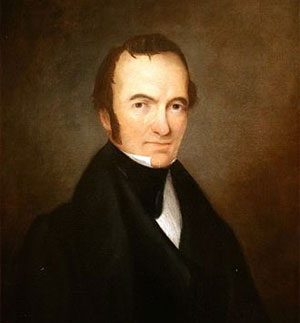 He brought 300 American families to the lower Colorado and Brazos rivers to establish a settlement in January, 1822. At that time, Texas was owned by Mexico and the Mexican government was responsible for safeguarding the colonists from Indian raids and outlaw desperados that roamed the area. Later, when Texas gained independence, the United States assumed responsibility for the protection of U.S. citizens who had immigrated to the area to establish homes and began the farming and raising of cattle that would provide for their livelihood. To achieve the protection, Texas became the home to many Army garrisons. Some of the forts were staffed with units of the Army's famed Buffalo Soldiers and in 1870, one soldier, Sgt. Emmanuel Stance, stationed at Fort McKavett was the first Buffalo Soldier to earn the Medal of Honor. Unfortunately, most of the forts have long since been destroyed with building materials from the deconstruction used by settlers for their houses and businesses. There are still stone foundations left from the original buildings and some of the fort's current caretakers have rebuilt officer quarters and other buildings. Those replicas are open to visitors and provide an idea of what life inside the forts was like during the time of their occupancy.
He brought 300 American families to the lower Colorado and Brazos rivers to establish a settlement in January, 1822. At that time, Texas was owned by Mexico and the Mexican government was responsible for safeguarding the colonists from Indian raids and outlaw desperados that roamed the area. Later, when Texas gained independence, the United States assumed responsibility for the protection of U.S. citizens who had immigrated to the area to establish homes and began the farming and raising of cattle that would provide for their livelihood. To achieve the protection, Texas became the home to many Army garrisons. Some of the forts were staffed with units of the Army's famed Buffalo Soldiers and in 1870, one soldier, Sgt. Emmanuel Stance, stationed at Fort McKavett was the first Buffalo Soldier to earn the Medal of Honor. Unfortunately, most of the forts have long since been destroyed with building materials from the deconstruction used by settlers for their houses and businesses. There are still stone foundations left from the original buildings and some of the fort's current caretakers have rebuilt officer quarters and other buildings. Those replicas are open to visitors and provide an idea of what life inside the forts was like during the time of their occupancy.
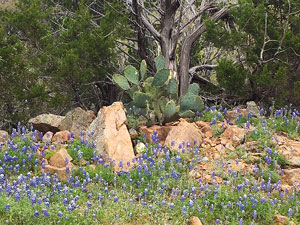 For this trip, LaVerne and I decided to use Fredericksburg as a home base and then tour Fort Martin Scott, Fort Mason, Fort McKavett, and the Presidio of San Saba. We left Houston and headed out Hwy 290 on a relatively clear day. Texas had been inundated with a lot of rain in the early spring and we weren't sure how long the weather would hold out for our excursion. About 11 miles east of Fredericksburg, we stopped at the Texas Wildseed Farm to check on the wildflowers. They grow huge fields of bluebonnets for their seeds and the flowers are beautiful when they are in bloom. Unfortunately, they were just beginning to show their blue heads although they were still small and sparse. We were disappointed when we saw that we were a little early for the wild flowers, but the next day as we made our way to Fort Mason, our disappointment turned to disbelief as we saw dazzling fields of bluebonnets covering both sides of every road we traveled. Now, it is a rule that anyone who drives the roads of our state during the spring must take time to observe the colorful blossoms. Just driving without voicing the obligatory "Oooohs" and "Ahhhhs, would surely incur the wrath of the bluebonnet Gods! Not wanting to take chances, we made a side excursion through the Willow City loop to view the flowers. That was a detour well worth our time as the bluebonnets were as high as the proverbial elephant's eye and were a beautiful deep blue color that accented the white tips of the flower. Feasting our eyes on the abundance of wildflowers, we continued on Hwy 16 to Llano and then turned onto Hwy 29 west towards Mason and the first stop on our Texas fort tour.
For this trip, LaVerne and I decided to use Fredericksburg as a home base and then tour Fort Martin Scott, Fort Mason, Fort McKavett, and the Presidio of San Saba. We left Houston and headed out Hwy 290 on a relatively clear day. Texas had been inundated with a lot of rain in the early spring and we weren't sure how long the weather would hold out for our excursion. About 11 miles east of Fredericksburg, we stopped at the Texas Wildseed Farm to check on the wildflowers. They grow huge fields of bluebonnets for their seeds and the flowers are beautiful when they are in bloom. Unfortunately, they were just beginning to show their blue heads although they were still small and sparse. We were disappointed when we saw that we were a little early for the wild flowers, but the next day as we made our way to Fort Mason, our disappointment turned to disbelief as we saw dazzling fields of bluebonnets covering both sides of every road we traveled. Now, it is a rule that anyone who drives the roads of our state during the spring must take time to observe the colorful blossoms. Just driving without voicing the obligatory "Oooohs" and "Ahhhhs, would surely incur the wrath of the bluebonnet Gods! Not wanting to take chances, we made a side excursion through the Willow City loop to view the flowers. That was a detour well worth our time as the bluebonnets were as high as the proverbial elephant's eye and were a beautiful deep blue color that accented the white tips of the flower. Feasting our eyes on the abundance of wildflowers, we continued on Hwy 16 to Llano and then turned onto Hwy 29 west towards Mason and the first stop on our Texas fort tour.
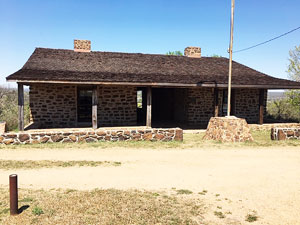 Fort Mason was established in 1851. The fort served as a front-line defense against Indian attacks on the settlers in the area. The fort was built at the top of a hill overlooking the city of Mason. The porch of the re-constructed officer's quarters, provides a great vantage point to view any activity in the surrounding area and would have offered protection from surprise attacks during that time. The fort was closed in 1854 but after an increase in horse thefts in the area, it was re-occupied in 1856. Fort Mason was Robert E. Lee's last command with the United States Army. When Texas seceded from the Union,
Fort Mason was established in 1851. The fort served as a front-line defense against Indian attacks on the settlers in the area. The fort was built at the top of a hill overlooking the city of Mason. The porch of the re-constructed officer's quarters, provides a great vantage point to view any activity in the surrounding area and would have offered protection from surprise attacks during that time. The fort was closed in 1854 but after an increase in horse thefts in the area, it was re-occupied in 1856. Fort Mason was Robert E. Lee's last command with the United States Army. When Texas seceded from the Union, 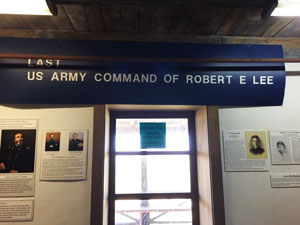 Lee was ordered out of the state and back to his home state of Virginia. He was a proven hero during the Mexican-American War and served on the staff of General Winfield Scott. Lee's aversion to the Civil War was apparent in a conflicted statement he wrote to his sister following his decision to join the Confederate Army rather than fight against his home state of Virginia; "I can anticipate no greater calamity for the country than dissolution of the union. Secession is nothing but revolution." After the Civil War, the United States Army returned to Fort Mason in 1866. The War had increased civil disobedience and after many attacks, the soldiers began to abandon the fort leaving the remaining 25 buildings in poor shape. The fort was closed again in 1869 but later reopened by the Texas frontier forces. The fort was closed for good in 1871. The city of Mason began a restoration of the fort in 1975 and today the fort belongs to the Historical Society.
Lee was ordered out of the state and back to his home state of Virginia. He was a proven hero during the Mexican-American War and served on the staff of General Winfield Scott. Lee's aversion to the Civil War was apparent in a conflicted statement he wrote to his sister following his decision to join the Confederate Army rather than fight against his home state of Virginia; "I can anticipate no greater calamity for the country than dissolution of the union. Secession is nothing but revolution." After the Civil War, the United States Army returned to Fort Mason in 1866. The War had increased civil disobedience and after many attacks, the soldiers began to abandon the fort leaving the remaining 25 buildings in poor shape. The fort was closed again in 1869 but later reopened by the Texas frontier forces. The fort was closed for good in 1871. The city of Mason began a restoration of the fort in 1975 and today the fort belongs to the Historical Society.
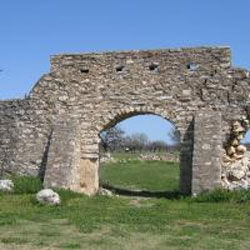 The Presidio of San Saba is located west of Mason and just outside of Menard. The Presidio was established in 1757 to protect Spanish interests in the area, including the Mission Santa Cruz de San Saba. Unfortunately, the mission was destroyed and burned by nearby hostile Indians only one year after it was built. The Presidio was abandoned a decade later and was later restored by the 1936 Texas Centennial Commission. The city of Menard is currently helping to preserve the archeological remains and many years have been spent uncovering artifacts from the site and from the Spanish Colonial period in Texas.
The Presidio of San Saba is located west of Mason and just outside of Menard. The Presidio was established in 1757 to protect Spanish interests in the area, including the Mission Santa Cruz de San Saba. Unfortunately, the mission was destroyed and burned by nearby hostile Indians only one year after it was built. The Presidio was abandoned a decade later and was later restored by the 1936 Texas Centennial Commission. The city of Menard is currently helping to preserve the archeological remains and many years have been spent uncovering artifacts from the site and from the Spanish Colonial period in Texas.
Unfortunately, the rains came and we were unable to continue on to Fort McKavett. (The picture below is from an earlier visit.) This Fort is one of the most complete examples of a Texas military post. 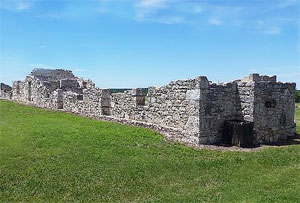 It is said that General William Sherman described the fort as "the prettiest post in Texas." Many of the old buildings have been restored including the officers' quarters, barracks, hospital, school house, and the post headquarters. I previously visited the fort with my brother and LaVerne while we were on our way to New Mexico. My brother had filmed documentary footage of the fort many years earlier and he gave LaVerne and me a mini tour of the fort showing us the still visible traces of the wagon ruts made by early traveling settlers. This gave a ghostly testament to numbers of people who had passed through on their way to California and a better life. The fort was established in 1852 as security for the settlers in the area and to also serve as a rest stop for the travelers. In 1859, the fort was abandoned since most of the Native Americans had been moved to reservations in Texas. Fort McKavett was re-opened in 1868 to control hostilities in the area between Comanche Indians and settlers. Later the fort served as a supply depot during the period from 1868 to 1883. The fort was abandoned in 1883 and settlers moved into the buildings and formed the town of Fort McKavett.
It is said that General William Sherman described the fort as "the prettiest post in Texas." Many of the old buildings have been restored including the officers' quarters, barracks, hospital, school house, and the post headquarters. I previously visited the fort with my brother and LaVerne while we were on our way to New Mexico. My brother had filmed documentary footage of the fort many years earlier and he gave LaVerne and me a mini tour of the fort showing us the still visible traces of the wagon ruts made by early traveling settlers. This gave a ghostly testament to numbers of people who had passed through on their way to California and a better life. The fort was established in 1852 as security for the settlers in the area and to also serve as a rest stop for the travelers. In 1859, the fort was abandoned since most of the Native Americans had been moved to reservations in Texas. Fort McKavett was re-opened in 1868 to control hostilities in the area between Comanche Indians and settlers. Later the fort served as a supply depot during the period from 1868 to 1883. The fort was abandoned in 1883 and settlers moved into the buildings and formed the town of Fort McKavett.
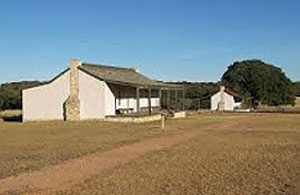 The next day, we left Fredericksburg to head back to Houston with a stop by Fort Martin Scott located about 2 miles east of Fredericksburg on Hwy 290. The fort was first called Camp Houston when it was established in 1848. The post was renamed in honor of Major Martin Scott, who had been killed at the battle of Molina Del Rey in 1847 during the war with Mexico. This fort also served as defense for keeping the peace between the Comanche Indians and the German settlers who lived in the area. Fredericksburg signed a peace treaty with the Comanche chief, Santana, in May of 1847. The treaty is a rarity amongst Indian treaties in that it has never been broken. Fort Martin Scott had twenty one buildings when it was established. As the frontier moved further west, the need for the protection of the fort diminished and if was used as a forage depot until being abandoned at the end of 1866. The City of Fredericksburg purchased the fort in 1959. Many of the original buildings have been restored and the fort hosts several staged events throughout the year.
The next day, we left Fredericksburg to head back to Houston with a stop by Fort Martin Scott located about 2 miles east of Fredericksburg on Hwy 290. The fort was first called Camp Houston when it was established in 1848. The post was renamed in honor of Major Martin Scott, who had been killed at the battle of Molina Del Rey in 1847 during the war with Mexico. This fort also served as defense for keeping the peace between the Comanche Indians and the German settlers who lived in the area. Fredericksburg signed a peace treaty with the Comanche chief, Santana, in May of 1847. The treaty is a rarity amongst Indian treaties in that it has never been broken. Fort Martin Scott had twenty one buildings when it was established. As the frontier moved further west, the need for the protection of the fort diminished and if was used as a forage depot until being abandoned at the end of 1866. The City of Fredericksburg purchased the fort in 1959. Many of the original buildings have been restored and the fort hosts several staged events throughout the year.
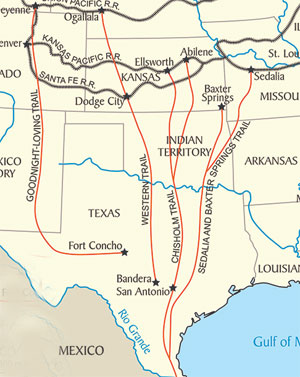 Following the Texas Fort Trail gives the traveler a perspective of life in Texas during the 1800s. Looking at a map of the state, it is interesting to note that all of the forts were built west of a line from Fort Worth down to Brownsville. The number of forts built increased along 3 of the 4 major cattle trails - the Chisholm Trail from San Antonio to Abilene, Kansas, The Western Trail from Bandera to Ogallala, Nebraska, and the Goodnight – Loving Trail from San Angelo west towards El Paso and then north to Cheyenne, Wyoming. The Shawnee Trail, also known as the Sedalia and Baxter Springs Trail, in East Texas went through the more populated areas of the state and the protection of forts was not needed as much as in the wilder, more unsettled western part of the state. With all the hardships settlers had to face as they made their way across Texas, the forts fulfilled their purpose to serve as a harbor of safety for those brave pioneers who helped settle the west.
Following the Texas Fort Trail gives the traveler a perspective of life in Texas during the 1800s. Looking at a map of the state, it is interesting to note that all of the forts were built west of a line from Fort Worth down to Brownsville. The number of forts built increased along 3 of the 4 major cattle trails - the Chisholm Trail from San Antonio to Abilene, Kansas, The Western Trail from Bandera to Ogallala, Nebraska, and the Goodnight – Loving Trail from San Angelo west towards El Paso and then north to Cheyenne, Wyoming. The Shawnee Trail, also known as the Sedalia and Baxter Springs Trail, in East Texas went through the more populated areas of the state and the protection of forts was not needed as much as in the wilder, more unsettled western part of the state. With all the hardships settlers had to face as they made their way across Texas, the forts fulfilled their purpose to serve as a harbor of safety for those brave pioneers who helped settle the west.
Let us know what your favorite things to do or places to go were when you were younger. Go to the CONTACT US page and email the information or any comment you have about the trips that have been featured. We always want to hear from our friends and neighbors!